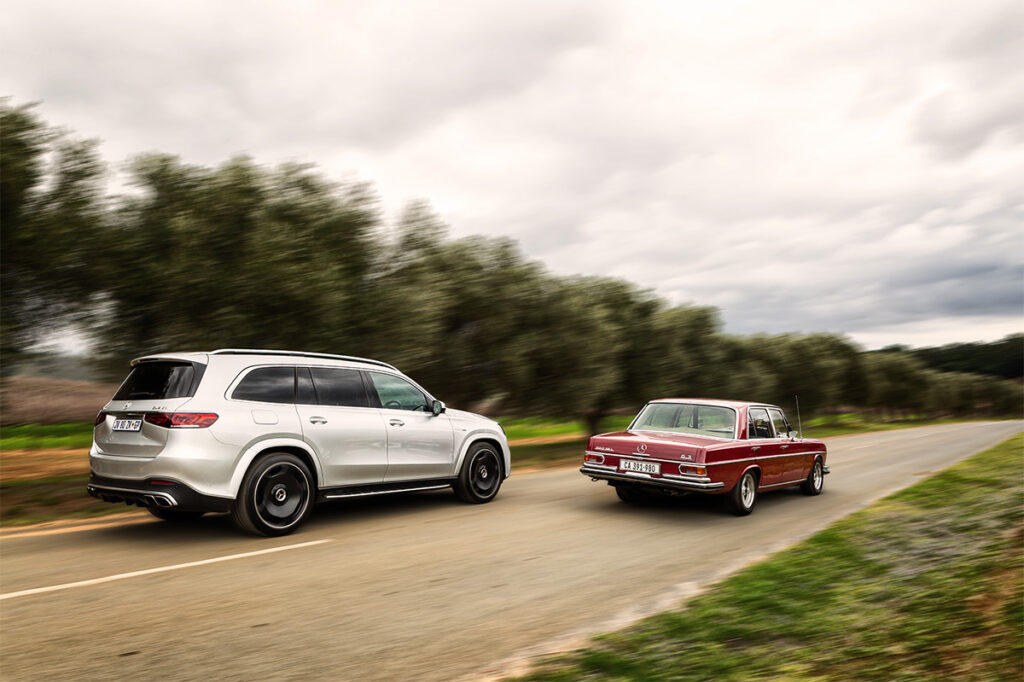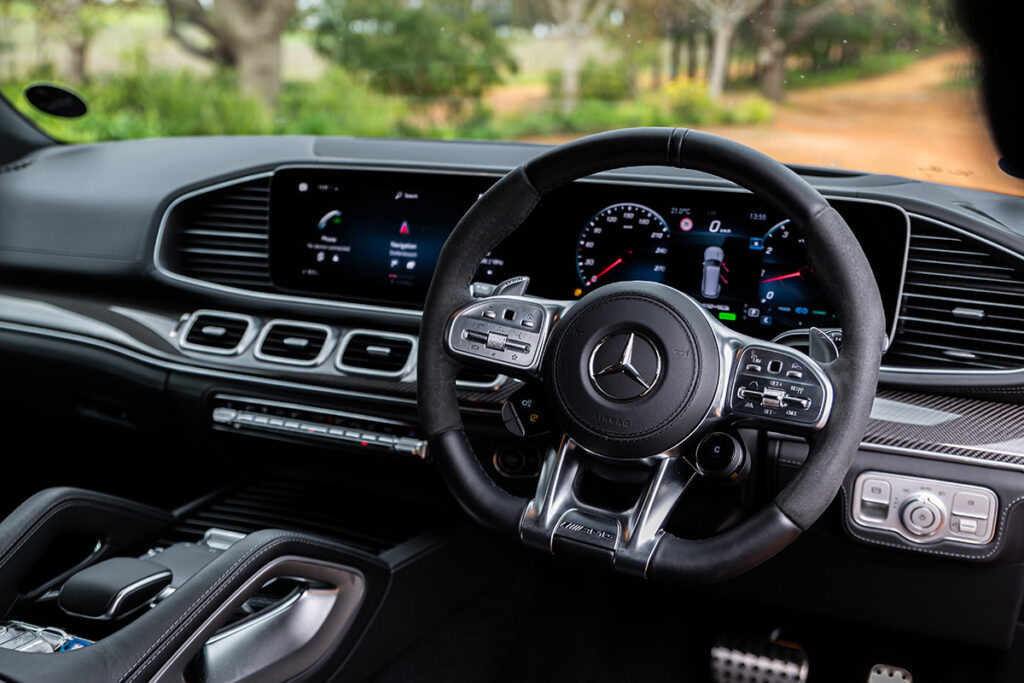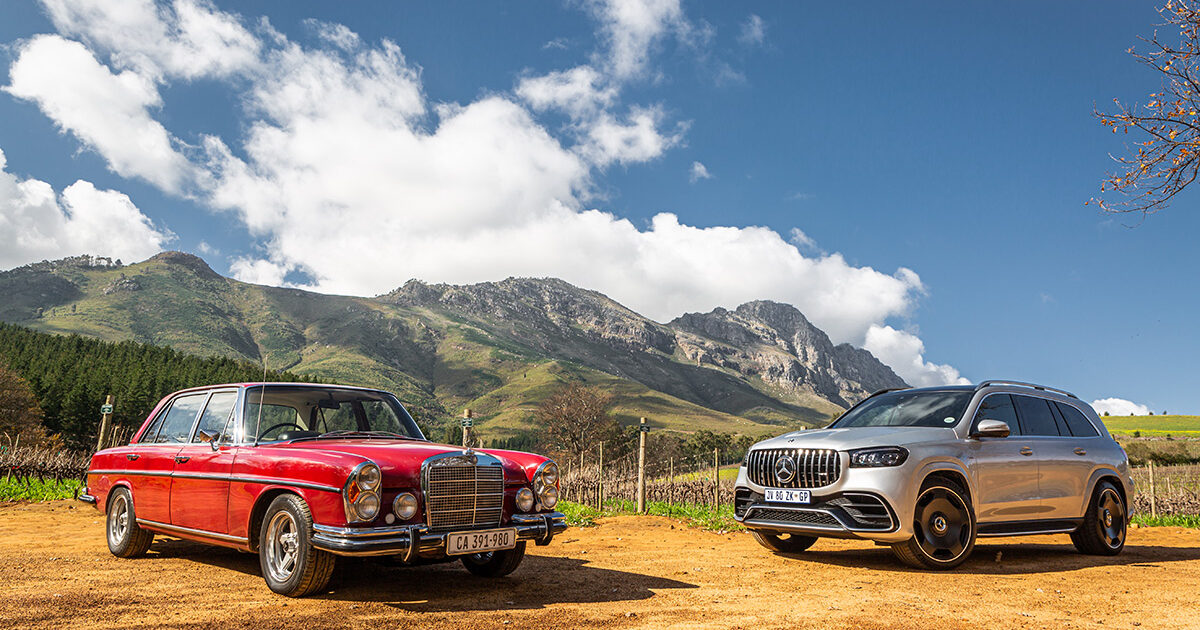The Stellenbosch Wine Route is celebrating its golden anniversary this year. To commemorate this milestone, we visited Delheim, where the founding fathers of the route gave substance to their dream, in the latest MercedesAMG GLS 63 4Matic+ and a 50-year-old MercedesBenz 300 SEL 6.3.
“Every story has a beginning and an end,” wrote R.C. Richter in Crossing the Rubicon. “What lies between those two points is the journey.” In South Africa, the journey of wine tourism began when two pioneers of the nascent Stellenbosch wine industry, Frans Malan of Simonsig and Niel Joubert of Spier, were driving along the Route des Vins in Burgundy, France, in 1969.
“Why don’t we do something similar back home?” they asked themselves. So, the pair teamed up with Spatz Sperling of Delheim and, after two years of hectic lobbying with producers, the Stellenbosch Wine Route (SWR) opened in 1971, with 20 participating farms. Little did the “Big Three” know their efforts would cause the radical transformation of both wine production and consumption, as well as tourism.
The three, explains Malan’s son Johann, were the force behind the Cape Estate Wine Producers Association, which was formed to protect the interests of the few estates that bottled under their individual names. “When we got our licence in 1968, we were only the fifth estate to do so,” says Malan, currently director of winemaking and production at Simonsig.
“Wine-drinking was almost unheard of outside the Western Cape and there was no incentive for estates to bottle individually. It was much more convenient for them to supply bulk wine to coops and organisations such as Stellenbosch Farmers Winery (SFW), Bergkelder, and KWV that matured, bottled, and marketed under their brand names.”
Malan recalls that independent producers encountered harsh resistance from “the big boys”: “SFW bought about 95% of our wine but suddenly stopped, saying the fact that we sold directly to the public put us in competition.”
By the time the SWR opened, the founding estates had been joined by others such as Muratie, Blaauwklippen, Neethlingshof, Hazendal, Overgaauw, Hartenberg, Rust-en-Vrede, Koopmanskloof, and a couple of the smaller cooperative cellars (some participating estates – Verdun, Montagne, and Uiterwyk among them – no longer exist).
“We used to do cellar tours and tastings on Saturday mornings but later, when my parents went off to play tennis, people would still come knocking. I would grab my father’s cellar keys and show them around before letting them buy a case or two. I was twelve years old,” recalls Malan.
“At that stage we had just released our Kaapse Vonkel, South Africa’s first sparkling wine made using traditional French methods. At R3.00 a bottle, it was the most expensive wine in the country.”
Sperling’s children are younger than Malan but played their parts in putting Delheim on the SWR map which, incidentally, their art-schooled mother drew up. “We kids worked every weekend, every holiday … doing anything that had to be done to make the place a success,” says Delheim codirector Nora Sperling-Thiel.
An often-told story about the Sperling youngsters (Nora’s brother Victor is the other director) relates to the pressure those same “big boys” was able to exert on the erstwhile Cape Provincial Administration to discourage the upstarts. The original road signage bore the SWR logo, its name, and a number that corresponded to the stop on the route-map, but no estate identification.
“We were number three and Simonsig was number five. Number three did not mean anything, so Victor and I had to stand out on the main road with a Delheim sign,” says Sperling-Thiel. The siblings would dive into the bushes when they spied anything resembling a police vehicle and reemerge when the danger passed. The main road was about five kilometres from the farm.
“The immediate success of the route caught everyone by surprise,” Sperling-Thiel adds. “We did not have facilities in the tasting room and visitors queued to go to the toilet in our house. This was when we regularly had up to 600 people a day coming by! Unlike today, when visitors can buy single bottles of wine, the original SWR explorers could only purchase cases of 12 bottles.”
This restriction prompts a 50year flashback for Vera Sperling, Spatz’ widow, who still lives on Delheim. “One of my earliest memories of those days was watching Dr Baker – the man who owned Bakers Biscuits in Cape Town – loading cases of wine into the boot of his MercedesBenz.”

Golden jubilee in two Merc’s
This anecdotal story inspired us to celebrate the golden jubilee of the route by visiting the farm in the latest MercedesAMG GLS 63 4Matic+ – power-flagship in the GLS range – and a rare and sought after 1970 MercedesBenz 300 SEL 6.3, described as the best and fastest sedan in its heyday and just the type of vehicle for a grand tour through the winelands back then …
Viewed as the pinnacle of MercedesBenz luxury performance sedans of yesteryear, the 300 SEL feature the potent 6.3litre M100 V8 engine from the flagship 600 Limousine. Delivering 184 kW and 503 Nm of torque, the hand-built 6 332 cc power plant could propel the big SClass to 100 km/h in 6.5 seconds – insanely fast for the time – and to a top speed of 220 km/h.
In highly tuned racing form the 300 SEL also was the “founding father” of the AMG brand, now the world-renowned performance arm of MercedesBenz. Also, the M156 engine in the GLS 6.3 in fact displaces 6.2 litres (6 208 cc), yet it is marketed as the “6.3” to commemorate the famed M100, the first production V8 from MercedesBenz.
For its era, the 300 SEL 6.3 was extremely luxurious, with standard features such as air suspension, ventilated disc brakes, electric windows, central locking, and power steering. Air-con, a power sunroof, a Becker audio tape deck, rear window curtains, writing tables, and reading lamps were optionally available.
We sourced an impeccably maintained 6.3 from Laude Classic Cars in Cape Town, shod with alloy wheels fashioned after the five-spoke rims used by the first AMG tuned Merc, while the shiny new GLS 63 featured special 23inch matt black wheels (an R68 200 option) patterned after the original AMG Monoblock deep dish rims …
With its single overhead cam V8 merrily rumbling along, the powerful old-timer had no trouble following the modern SUV on the highway towards Stellenbosch. Its big steering wheel and unsupportive seats (by modern standards) took some getting used to, and its ride was somewhat floaty compared to the stiff setup of current vehicles.
The four-speed auto ‘box was also slow measured against modern transmissions but its good performance and surprisingly effective brakes made it hard to believe the SEL is over half a century old. Still, while classified as a large sedan in the ’seventies, it appeared modest parked next to the GLS at Delheim.
The biggest AMG model combines striking design, exclusive appointments, and space for up to seven people, with exemplary driving dynamics. It is not called the “SClass among SUVs” for nothing, yet while badged GLS 63 it is powered by a 4.0litre V8 biturbo engine that delivers 450 kW and 850 Nm of torque and is equipped with an integrated EQ Boost starter-alternator that briefly can deliver an additional 16 kW and 250 Nm of torque …
This power is sent to all four wheels via a ninespeed auto transmission, blasting the big SUV from zero to 100 km/h in just 4.2 seconds and a top speed limited to 250 km/h (although 280 km/h is possible with the optional AMG Driver’s package).
The exterior is expressive and sporty, and the signature radiator grille with vertical louvres, power domes on the bonnet, and angular twin tailpipes with characteristic ribbing makes it immediately recognisable as an AMG.
Inside, highlights include climatised multi-contour nappa leather seats, a new AMG Performance steering wheel, the digital Widescreen Cockpit with advanced MBUX infotainment system, and AMG specific display styles. A significantly longer wheelbase compared to its predecessor ensures more legroom and space for second seat row passengers.
With standard-fit AMG Ride Control+ air suspension and adaptive adjustable damping ADS+, the immensely powerful GLS literally glided over smooth road surface and with its lowered ride height (10 mm in the Sport and Sport+ programmes) it felt smaller and more compact than its actual size in corners.
The GLS 63 4Matic+ is also quite capable off-road, thanks to “Trail” and “Sand” drive modes, settings such as “gradient”, “inclination”, and “differential lock”, and raised ride height (up to 55 mm). However, taking on anything but a good dirt road with those wide and low-profile 23inch tyres, is not advised …

The present
The Stellenbosch Wine Route may have had a small beginning but after five decades it has a membership of just over 100 estates and cooperative cellars; down from the peak of 176 members when affiliation was still free. “Today, the wine route has five sub-routes offering diverse wine tourism experiences,” says SWR general manager Elmarie Rabie.
“This varies from all-inclusive luxury wine estates with tasting rooms, restaurants, and accommodation, to small boutique wineries. These sub-routes – Bottelary Hills, Greater Simonsberg, Helderberg, Stellenbosch Valley, and Stellenbosch Berg – are based on their physical proximity to one another in order to make travelling along the route even more user friendly.”
In 2019, SWR became a founding member of Visit Stellenbosch, the official destination marketing organisation for the town. “Previously, Stellenbosch 360 promoted tourism and Stellenbosch Wine Routes marketed about 150 estates in the region,” says Visit Stellenbosch GM Jeanneret Momberg.
“There was very little alignment in their respective marketing strategies, which made no sense because – if you think about it – wine is the main reason people come to Stellenbosch. In addition, nearly all the estates have restaurants or accommodation and feature some form of activity other than wine-tasting and cellar tours.”
According to recent research, more than 350 000 people travel to Stellenbosch annually just to visit wine farms and preCovid, wine tourism contributed R7.2bn to GDP per year.
The versatile new GLS 63, with its effortless performance and spaciousness, is an ideal long-distance cruiser, and with rough-terrain attributes and space for up to seven people it is the perfect wine tour companion …
Text: Jim Freeman / Ferdi de Vos | Images © Ryan Abbott


